
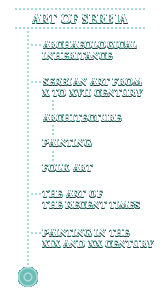



|
Until the time of the Slovene settlement, on several occasions the territory of present day Serbia represented the center of the civilized world. Often, it was the cradle of ideas and at times it had a significant influence on the cultural, economic and political history of Europe.
A millennium later, between 4500 and 3500 years before our age a large settlement of Danubean agriculturists developed the area of today's Belgrade at the sight of Vinca, a metropolis of one of the most glittering cultures of the European prehistory. The inhabitants of prehistoric Vinca and their fellow tribesman in Banat, Pomoravlje and Kosovo and Metohija had established a very specific culture during the earlier stone age called VINCAN CULTURE VATIN CULTURE, created after the fall of Vincan Culture, was founded 1600 years before our age and is characterized by stone and bone carvings and the formation and decoration of clay dishes. The specific decorative style expressed on the items of the Vatin culture is found on the items discovered in the Kings Circle of tombs in Mikena originating from the middle XVI century before our age.
By the end of the III and in the first decades of the IV century at the time of Dioklecian, Galerian, Licinis and the Great Constantine's reign the magnificent architectonic ensembles were built- Romuliana (Gamzigrad near Zajecar), Mediana (Brzi Brod near Nis) and Justiniana Prima (Cesarean City near Lebane).
Handicraft was significantly developed during the reign of Constantine the Great. The imperial crafts of Nais (Nis) included silver dishes which were used as gifts for army commanders. At the end of the VI and in the first decade of the VII century there was a fall in creativity. The increased pressure of the barbarians on the inhabitants of Panonian, Dakijan and Dardanian forced them to withdraw towards the southern part of the Balkan peninsula. The Danubian region was depopulated and during the second decade of the VII century, during the reign of the Czar Iraklije, all the territories of modern Serbia were conquered by the Avars and Slovenes. |
Email: ooc@srbija.sr.gov.yu
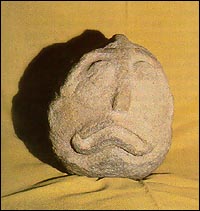 During IX-VIII millennium before our age the local population established a unique and long lasting culture in the Djerdap area. The period is named for the location of its peak, THE LEPENSKI VIR CULTURE. In this location two great cultural heritages were created: sacral architecture with monumental sculptures, which expressed a special vision of the world and the mastery of domestication of plants and animals, founding the new economy based on food production.
During IX-VIII millennium before our age the local population established a unique and long lasting culture in the Djerdap area. The period is named for the location of its peak, THE LEPENSKI VIR CULTURE. In this location two great cultural heritages were created: sacral architecture with monumental sculptures, which expressed a special vision of the world and the mastery of domestication of plants and animals, founding the new economy based on food production.
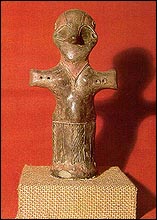 which dominated all of middle and southeastern Europe. Vinca and some other Neolite settlements in the vicinity of Vrsac (Potporanj), Kragujevac (Grivac, Divostin), Kosovska Mitrovica (Valac) and Pristina (Predionica) became big religious centers and focal points for art and had a crucial influence on the painting culture of all Neolite settlements of middle and southeastern Europe. Hundreds of thousands of clay figures and ritual vases found in the mentioned settlements reveal not only the extraordinary imagination and artistic ability of their creators but also the development of myth and the rapid expansion of magic religious practices within the Vincan culture. This special sacral world lived in the Balkan peninsula up to the time of the spreading of Christianity. Part of it is most probably embedded in the foundation of ancient European mythology i.e. old Greek myths about Demetra, Dionis and the divine blacksmith, Hefest.
which dominated all of middle and southeastern Europe. Vinca and some other Neolite settlements in the vicinity of Vrsac (Potporanj), Kragujevac (Grivac, Divostin), Kosovska Mitrovica (Valac) and Pristina (Predionica) became big religious centers and focal points for art and had a crucial influence on the painting culture of all Neolite settlements of middle and southeastern Europe. Hundreds of thousands of clay figures and ritual vases found in the mentioned settlements reveal not only the extraordinary imagination and artistic ability of their creators but also the development of myth and the rapid expansion of magic religious practices within the Vincan culture. This special sacral world lived in the Balkan peninsula up to the time of the spreading of Christianity. Part of it is most probably embedded in the foundation of ancient European mythology i.e. old Greek myths about Demetra, Dionis and the divine blacksmith, Hefest.
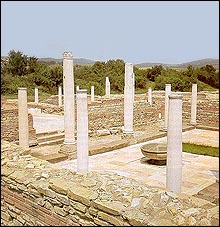 The territory of present day Serbia was under the ROMAN EMPIRE for six centuries. During that time the towns of Sirmium, Singidunum, Viminacium, Nais, Ulpiana developed and bridges and roads were built as well as a few imperial palaces and summer houses.
The territory of present day Serbia was under the ROMAN EMPIRE for six centuries. During that time the towns of Sirmium, Singidunum, Viminacium, Nais, Ulpiana developed and bridges and roads were built as well as a few imperial palaces and summer houses.
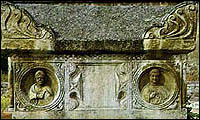 Construction activity began in all larger cities and especially in Sirmium (Sremskoj Mitrovici) which at the time had a large forum , an imperial palace with a hippodrome, luxurious baths, many palaces, a theater and an amphitheater. Many frescoes and sculptures have been discovered in this area.
Construction activity began in all larger cities and especially in Sirmium (Sremskoj Mitrovici) which at the time had a large forum , an imperial palace with a hippodrome, luxurious baths, many palaces, a theater and an amphitheater. Many frescoes and sculptures have been discovered in this area.